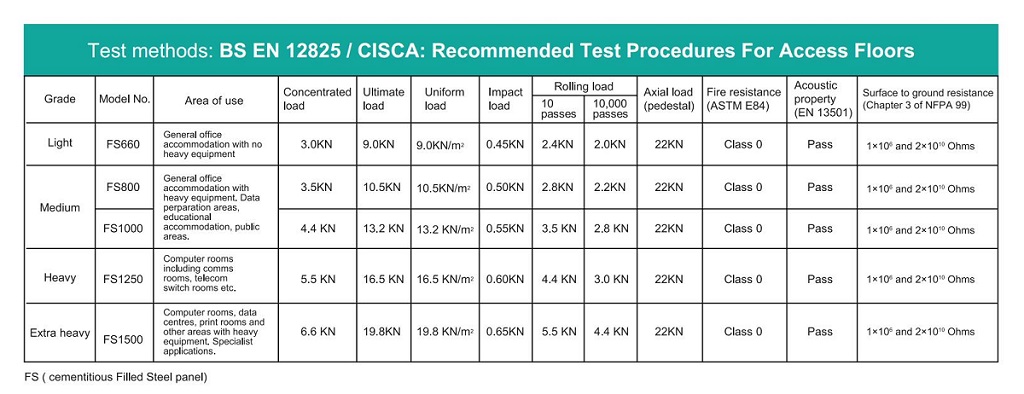NEWS TAG
brand
Huiya Raised Floor Systems have complied with the Common European Standard BS EN 12825 which is a method of comparing raised flooring performance (rolling load, impact load, uniform load) using a common test method. To ensure every Access Floor Tile reaches the BS EN specification, we test our Raised Floor Load rates before sending it out of the factory, based on CISCA Recommended Test Procedures for Access Floors. Also with the testing, we classify our raised access flooring products by structural performance, which can help customers select a raised access flooring system suitable for the building concerned.
Raised Access Floor BS EN 12825 Specification
BS EN 12825 was introduced in 2001 and a common Raised Floor standard in the UK, in Europe and around the world. BS EN 12825 outlines classifications for raised access floor systems based on their ultimate load and allows for a large number of classes, which can be used as a picking list to create a specification. This standard specifies the characteristics and performance requirements of raised access floors for which the main intended use is the internal fitting out of buildings, providing full access to the services to the plenum. It is applicable to modular, factory made raised access flooring elements, comprising raised floor panels and access floor pedestals and defines the test methods and measurement.
The raised floor system has been tested to withstand the ultimate load up to the point of failure. To determine the classification of the flooring system, the deflection of the floor is measured to produce an applied load/deflection map.
Elevated raised floor systems are classified according to ultimate load, safety factor, deflection under working load and dimensional tolerance. This allows for six types of ultimate loads ranging from greater than 4 kN to greater than 12 kN. For each of these six ultimate loads, 2 or 3 can be chosen as the safety factor. For these ultimate loads and safety factors, the maximum deflection is three-under working load conditions; for each ultimate load and safety factor, there are three maximum deflections. 2.5mm, 3.0mm, and 4mm.

Huiya Raised Flooring System BS EN 12825 Specification Testing
The BS EN 12825 test does not need to be carried out through a dedicated organization, and the manufacturer's own test results can be approved. To offer the best qualified Raised Access Flooring System to worldwide customers, we keep doing BS EN 12825 Testing for every panel. The below videos recorded the whole BS EN 12825 Specification testing procedures:
BS EN 12825 Specification Rolling Load Testing (CISCA 2500lbs)
Purpose: To determine the durability and/or deformation of an access floor system when exposed to commercially anticipated caster traffic using a specific load.
BS EN 12825 Specification Impact Load Testing (CISCA 2500lbs)
Purpose: To determine the effects and/or deformation of an access floor panel and understructure, when subjected to heavy loads being dropped onto the access floor system.
BS EN 12825 Specification Uniform Load Testing (CISCA 2500lbs)
Purpose: To determine the maximum deflection(s) and permanent set(s) of an access floor under a uniformly distributed load.
Check out our Raised Floor PSA MOB PF2 PS/SPU Test (Rolling Load, Impact Load, Uniform Load)
